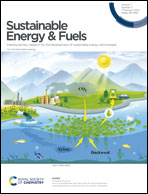Proton exchange membrane electrolysis of methanol for simultaneously synthesizing formaldehyde and hydrogen
Abstract
Electrolysis for upgrading molecules has received attention as a green process that can contribute to a sustainable society. In this study, methanol (MeOH) was converted into formaldehyde (FA) and H2via electrolysis using a membrane electrode assembly (MEA) device, wherein Nafion was used as a proton exchange membrane (PEM). Comparing various anode catalysts for PEM electrolysis, Pd/C is found to produce FA at a high faradaic efficiency (CH3OH → HCHO + 2H+ + 2e−). Pd loading and electrolysis voltage affect the FA formation rate. In the PEM electrolysis, the formed protons move toward the cathode through the Nafion membrane, and H2 is evolved on the cathode (2H+ + 2e− → H2), which indicates that this electrolysis system simultaneously yields FA and H2. A by-product, dimethoxymethane (DMM), is formed through the non-electrochemical acetalization of FA and MeOH, where Nafion serves as an acid catalyst. The formation of DMM is inhibited by stirring the electrolysis solution and adding a small amount of water. The FA formation rate (682 mmol gcat−1 h−1) in this study exceeds those reported in previous studies wherein FA is synthesized from the dehydrogenation of MeOH via heterogeneous catalytic and photocatalytic systems.



 Please wait while we load your content...
Please wait while we load your content...